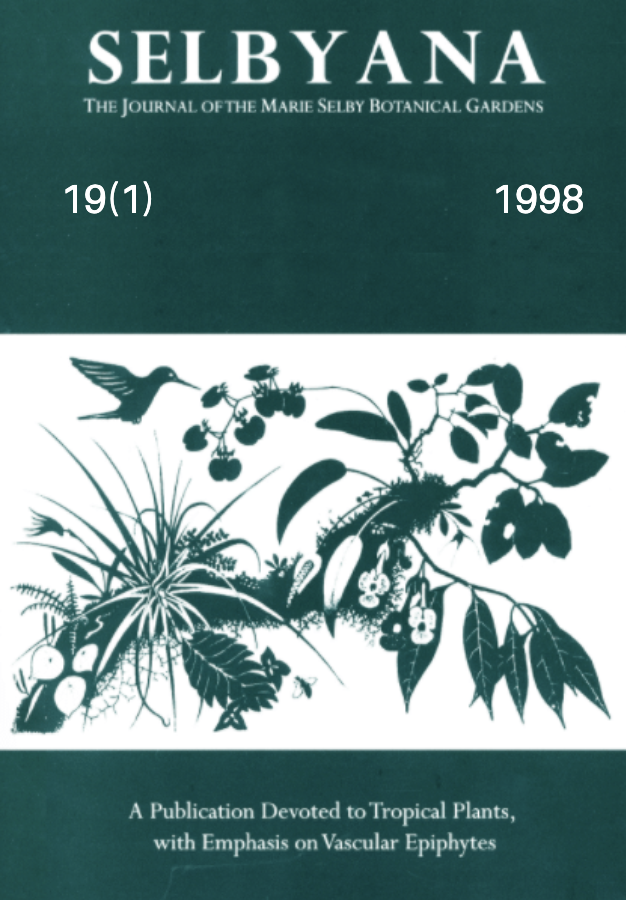Abstract
A total of 81 species of vascular epiphytes was collected from 22 selected branches of the middle and upper canopies of 16 phorophyte species. These phorophytes were characteristic and predominant species for the study area, a montane forest of the western slopes of the Ecuadorian Andes, 30 km southwest of Quito. With precise data of surface area (40.44 m²), length (761.27 m) and the various inclinations of all these branches, a typical structure of the tree crowns can be expounded. High inclinations are characteristic of small branches in the outer tree crown, small inclinations are predominant in large branches forming the inner parts of the crown—independent of the tree species. Phorophyte branch characteristics influence substrate thickness for epiphytes; substrate depends on branch inclination and branch diameter. With increasing branch diameter, average substrate thickness and average body size of epiphytes increase. The collection of 2,677 individuals of 81 epiphyte species and additionally 746 young and undeterminable individuals leads to a comprehension of the spatial distribution of epiphytic vegetation. Every branch can be divided into zones of different ages, these show different age levels of growing epiphytes. Younger twigs are colonized by a large number of juvenile individuals, older parts of branches are overgrown with fewer but generally more mature epiphytes. The number of species stays more or less constant with increasing branch age, but a turnover of certain species illustrates the succession of vascular epiphytes. Un total de 81 especies de epífítas vasculares fueron colectados de 22 ramas seleccionadas en el docel medio y superior de forofítas de 16 especies diferentes. Estas forofítas representan especies características y dominantes del área de estudio, un bosque montano de los Andes Ecuadorianos, 30 kilómetros al sudoeste de Quito. Datos exactos del area de superificie (40.44 m²), longitud (761.27 m) y inclinaciones de todas las ramas, permiten la reconstrucción de la estructura típica de las copas de los árboles. Inclinaciones altas caracterizan las ramas pequeñas en las zonas exteriores de las copas, inclinaciones suaves predominan en grandes ramas formando la parte interior de las coronas. Esta estructura general aplica a todas las especies de forofitas. Las características de las ramas de las forofítas tienen una influencia determinada en el espesor del sustrato de las epífitas, la cual depende de la inclinación de ramas y su diámetro. El aumento de diámetro resulta en un crecimiento de espesor de sustrato y el tamaño medio de las epífitas. La documentación de 2,677 individuos de 81 especies de epífitas (más 746 plantas juveniles no determinables) permite un concepto de la distribución espacial de la vegetación epífitica. Cada rama está compuesta de diferentes zonas de edad, que muestran un patrón correspondiente de epífitas de edades diferentes. Ramas juveniles están cubiertas por un gran número de individuos de epífitas juveniles, ramas de más edad están cubiertas de epífitas edultos. El número de especies queda constante en todas las zonas de las ramas, pero un cambio de especies indica un patrón de sucesión de epífitas vasculares.
Open Access and Copyright Notice
Selbyana is committed to real and immediate open access for academic work. All of Selbyana's articles and reviews are free to access immediately upon publication. There are no author charges (APCs) prior to publication, and no charges for readers to download articles and reviews for their own scholarly use. To facilitate this, Selbyana depends on the financial backing of the Marie Selby Botanical Gardens, the hard work and dedication of its editorial team and advisory board, and the continuing support of its network of peer reviewers and partner institutions.
Authors are free to choose which open license they would like to use for their work. Our default license is the Creative Commons Attribution-NonCommercial 4.0 (CC BY-NC 4.0). While Selbyana’s articles can be copied by anyone for noncommercial purposes if proper credit is given, all materials are published under an open-access license with authors retaining full and permanent ownership of their work. The author grants Selbyana a perpetual, non-exclusive right to publish the work and to include it in other aggregations and indexes to achieve broader impact and visibility.
Authors are responsible for and required to ascertain that they are in possession of image rights for any and all photographs, illustrations, and figures included in their work or to obtain publication or reproduction rights from the rights holders. Contents of the journal will be registered with the Directory of Open Access Journals and similar repositories. Authors are encouraged to store their work elsewhere, for instance in institutional repositories or personal websites, including commercial sites such as academia.edu, to increase circulation (see The Effects of Open Access).
